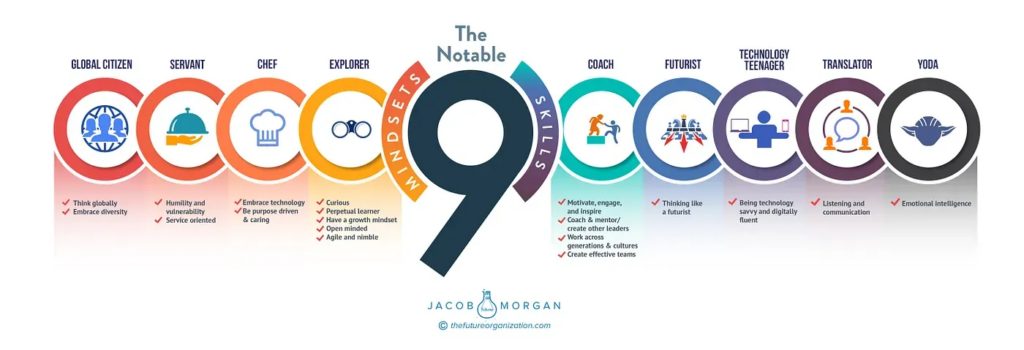This post first appeared for premium subscribers of Great Leadership on Substack and was published on November 1, 2023. If you want to get access to exclusive articles like this one and weekly 5 min leadership tips, then make sure to become a premium subscriber and get all of my best content and latest thinking delivered to your inbox. Learn more and sign up here. Premium subscribers get content like this every week.
…
If you’re a Chief Human Resources or Chief People Officer, then you can request to join a brand new community I put together called Future Of Work Leaders which focuses on the future of work and employee experience. Join leaders from Tractor Supply, Johnson & Johnson, Lego, Dow, Northrop Grumman and many others. We come together virtually each month and once a year in-person to tackle big themes that go beyond traditional HR.
In most companies you start off working as an employee, after you have proven your worth or if you have stayed at the company for a long time, then you are granted the keys to the mythical world of “leadership training.” It’s here where you actually learn to…lead.
In his book, “Principles of Scientific Management (1911), Frederick Winslow Taylor, a mechanical engineer by trade who became obsessed with improving efficiency, wrote.
Now one of the very first requirements for a man who is fit to handle pig iron as a regular occupation is that he shall be so stupid and so phlegmatic that he more nearly resembles in his mental make-up the ox than any other type. The man who is mentally alert and intelligent is for this very reason entirely unsuited to what would, for him, be the grinding monotony of work of this character. Therefore the workman who is best suited to handling pig iron is unable to understand the real science of doing this class of work. He is so stupid that the word “percentage” has no meaning to him, and he must consequently be trained by a man more intelligent than himself into the habit of working in accordance with the laws of this science before he can be successful.
Simply put, this means workers are not that smart or capable and therefore need to be trained by someone who is smarter and more capable than they are, aka, the manager.
Leadership was once viewed as the responsibility of a select few people who metaphorically and figuratively sat at the top of their organizations. However, over the years we have seen organizations become larger, more networked, distributed, and where we collectively are spending more time doing work with our minds instead of with our hands – shifting from manual to intellectual work.
In my last book, The Future Leader, I discovered that most people become leaders at some point in their early 20’s. Perhaps you’re leading a small team in a corporate headquarters or maybe you’re a supervisor in a retail store. However, these same people don’t get any formal leadership training until their mid to late 30’s and sometimes not even until their early 40’s!
I was recently speaking at a large organization with 500 leaders in attendance. I asked them how many of them received formal leadership training when they first got into their leadership roles. MAYBE a dozen hands went up in that entire room of 500.
There’s an old joke where the CFO goes up the CEO and says “What happens if we invest in developing our people and then they leave us?” to which the CEO responds with “What happens if we don’t, and they stay?”
Why wouldn’t you want everyone at your company to have leadership training?
In the rest of the article I’ll go over the business case for why ALL employees at your company should get leadership training
What does leadership training actually mean? In The Future Leader, I looked at 4 mindsets and 5 skills that are crucial for current and aspiring leaders. These include things like having a growth mindset, being curious, thinking like a futurist, and being emotionally intelligence.

I also looked at the top 13 behaviors of effective leaders according to some recent research from DDI. There are plenty of other studies that look at what these mindsets and skills are. The point is why wouldn’t you want EVERYONE at your company practice these things?
The skills and mindsets above (among others) are beneficial and indeed crucial for employees at all levels. These are things that help with problem solving, critical thinking, resiliency, creativity, adaptability, collaboration and much more.
…
Leadership is evolving rapidly—are you keeping up? Each year, I engage with and analyze the insights of leading executives from companies like Microsoft, IBM, and Virgin Group, uncovering the strategies that drive their success. This exclusive PDF distills the top five leadership hacks used by these world-renowned leaders. Discover what sets these leaders apart and how you can apply their breakthrough tactics to elevate your leadership in 2024 and beyond.
…
The ripple effect of leadership
Several studies point to that fact when employees on teams exhibit leadership qualities, those teams are more cohesive, innovative, and adaptable (Center for Creative Leadership). A study by Carmeli, Atwater, and Levi (2011) in “The Journal of Applied Behavioral Science” highlights how relational leadership among non-managerial employees contributes to organizational learning and effectiveness. Specifically employees who exhibit these skills inspire their peers to emulate the same behaviors.
Innovation
Employees who are not in formal leadership positions but who exhibit leadership qualities can drive innovation. Their willingness to question the status quo, suggest improvements, and take calculated risks encourages a culture of creativity. Müller, Turner, and Spang (2013) in “International Journal of Project Management” found that leadership at all levels was pivotal in fostering an environment conducive to innovation.
Decision-making
Leadership at various levels contributes to more diverse perspectives in decision-making processes. Employees who feel empowered to lead are more likely to contribute ideas and solutions, leading to more effective problem-solving. A study by Pearce and Conger (2003) in their book “Shared Leadership: Reframing the Hows and Whys of Leadership” argues that shared leadership can enhance decision-making quality and adaptability in dynamic environments.
Employee engagement and retention
Leadership behaviors among non-managerial staff can significantly impact employee engagement and retention. When employees at all levels feel they can exhibit leadership, they often feel more valued and invested in their work. According to Gallup’s “State of the American Workplace” report, engaged teams show significantly lower turnover rates, indicating the importance of leadership spread across organizational levels.
Adapting to change
We have seen more change in the past 5 years than we have in the past 50. Work today is not what it used to be and with the influx of tools like generative AI, work won’t be the same in the next few years as it is today. By giving all of your employees leadership training, you essentially future-proof your organization so that your employees are more capable of overcoming challenges and identifying new opportunities for growth.
The list goes on and on of why employees not yet in leadership roles should be taught leadership skills. In addition to the items mentioned above giving everyone access to leadership training creates a culture of learning and growth, build a leadership pipeline which is something many orgs are struggling with, and improves overall team performance.
In the words of Dolly Parton, “If your actions inspire others to dream more, learn more, do more, and become more, you are a leader.”
Let’s create an organization brimming with such leaders.
…
Leadership is evolving rapidly—are you keeping up? Each year, I engage with and analyze the insights of leading executives from companies like Microsoft, IBM, and Virgin Group, uncovering the strategies that drive their success. This exclusive PDF distills the top five leadership hacks used by these world-renowned leaders. Discover what sets these leaders apart and how you can apply their breakthrough tactics to elevate your leadership in 2024 and beyond.


